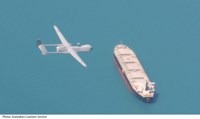Customs' unmanned spy plane protects Aussie borders

Customs is wrapping up an AU$5.5 million trial of an unmanned spy plane next week, used to keep watch for criminal activities such as illegal fishing.

UAV over a merchant ship
(Credit: Customs)
The unmanned aerial vehicle (UAV) is being used in a pilot to watch out for quarantine and border threats. It is based at Weipa, north Queensland, from which it has been flying over the Gulf of Carpentaria, Torres Strait and the Great Barrier Reef.
The 8.5-metre long "Heron" aircraft used in the trial, operated by Israel Aerospace Industries, can fly 1,800km on a single fuel tank as well as take off and land automatically.
Live radar, vessel information, video and photographs are transmitted from the UAV to its Weipa command centre via satellite, then pictures of interest are downloaded to laptops and transmitted to the BPC National Surveillance Centre in Canberra.
According to Nigel Perry, Border Protection Command's acting national director of maritime operations' support division, the plane flies a predetermined flight path, but isn't limited to that particular route: "If you want it to go somewhere else you click and flick and there it goes," he said.
Another advantage of the unmanned plane is that it can fly low and slow, down to 65 knots, allowing its cameras to pick up small detail such as the name of the ship on the hull, and the crew (so as to determine their ethnic heritage), or whether there are livestock on the ship.
The UAV is able to identify vessels over 300 gross tonnes automatically, because the International Maritime Organisation requires them to operate automatic identification systems at all times. These provide information such as the ship's identity, type, position, course and speed.
Perry hopes if the plane is adopted on a long-term basis, it will be controlled remotely from Canberra, so that those controlling the sensors on the craft can speak to operations personnel, helping them see "the big picture".
If the UAV becomes a permanent feature of border control, two new satellites to be launched at the end of this year will provide a dedicated communications link.
The aircraft's last scheduled flight will take place on 2 June, with Customs preparing a report on the trial by the end of the month. The government will then decide on whether to invest in the program on a long-term basis.
For photos of the UAV in action, see the related photo story.